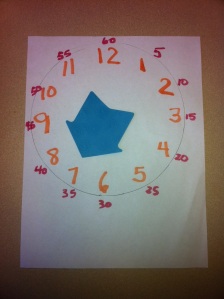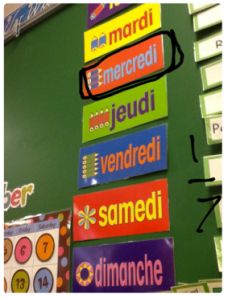 In this day of digital clocks and watches, more and more children are having trouble with telling time on analog timepieces. The clock face with its two (or three) hands remains shrouded in mystery for many of the students.
In this day of digital clocks and watches, more and more children are having trouble with telling time on analog timepieces. The clock face with its two (or three) hands remains shrouded in mystery for many of the students.
I recently had the privilege of going into a grade 5/6 classroom and doing a lesson with the students in the area of measurement. One of the parts of the lesson included telling time on an analog clock.
Each student was given a sheet of paper with a circle marked on it. Together we added the numbers 1 to 12 for the hours: first we placed the 12 and 6; then the 9 and 3; then we “filled in” between those anchor numbers. There was much discussion at that point about even that particular part of clocks. Student were quick to share that some clocks have only the four anchor number, some have Roman numerals for the hour numbers, and some clocks have no numbers at all – just lines or “ticks” marking the hours.
We discussed as a class the idea of half and quarter hours. Of course, this must be done in the context of the whole hour having 60 minutes. We also noted that in money quarters denote 25’s, but in time quarters denote 15’s. Finally we pointed out that with referring to quarters of hours we speak of “quarter past” or “quarter after” an hour, and we speak of “quarter to” or “quarter ‘til” an hour, but we do not usually refer to three-quarters past an hour.
Each student was also given a large Post-It note arrow to be used as the hour hand. I wanted to render the idea of telling time down to the most simplest elements, and thus set about showing how one can tell time with a reasonable degree of accuracy just by using the hour hand of the clock.
 We placed the arrow to show several “o’clock” times (e.g., 12:00, 4:00, 7:00 — see first picture) and then did some “half past” or “—thirty” times (e.g. 12:30, 4:30, 7:30–see second picture). The point of this is, of course, that when it is half past an hour, the hour hand has moved half the distance to the next hour number. Thus a 7:30 the hour hand is half-way between the 7 and the 8.
We placed the arrow to show several “o’clock” times (e.g., 12:00, 4:00, 7:00 — see first picture) and then did some “half past” or “—thirty” times (e.g. 12:30, 4:30, 7:30–see second picture). The point of this is, of course, that when it is half past an hour, the hour hand has moved half the distance to the next hour number. Thus a 7:30 the hour hand is half-way between the 7 and the 8.
We even pointed out that we could tell the quarters fairly closely as well. If, for instance, the hour hand were slightly past the 9, the time was approximately 9:15 or quarter past 9. Alternately, it the hour hand were slightly before the 10, the time was approximately 9:45 or quarter to 10.
We did add the minute numbers around our clock and discussed that using the minute hand added accuracy to our time reading, but by focusing on just the hour hand all of the students were able to make sense of the analog clock, some for the very first time.
Mathematically yours,
Carollee
 If you are looking for a great Christmas-themed book for the young (or young at heart), you will want to check out A Porcupine in a Pine Tree: A Canadian 12 Days of Christmas (written by Helaine Becker, illustrated by Werner Zimmerman). Of course, the math connection is in the counting and in the adding up of all the items being given during the 12 days – all totaled it adds up to quite a tidy sum.
If you are looking for a great Christmas-themed book for the young (or young at heart), you will want to check out A Porcupine in a Pine Tree: A Canadian 12 Days of Christmas (written by Helaine Becker, illustrated by Werner Zimmerman). Of course, the math connection is in the counting and in the adding up of all the items being given during the 12 days – all totaled it adds up to quite a tidy sum.









